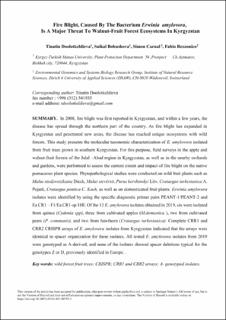Please use this identifier to cite or link to this item:
https://doi.org/10.21256/zhaw-21521Full metadata record
| DC Field | Value | Language |
|---|---|---|
| dc.contributor.author | Doolotkeldieva, Tinatin | - |
| dc.contributor.author | Bobushova, Saikal | - |
| dc.contributor.author | Carnal, Simon | - |
| dc.contributor.author | Rezzonico, Fabio | - |
| dc.date.accessioned | 2021-02-04T09:48:22Z | - |
| dc.date.available | 2021-02-04T09:48:22Z | - |
| dc.date.issued | 2021-01-28 | - |
| dc.identifier.issn | 1125-4653 | de_CH |
| dc.identifier.issn | 2239-7264 | de_CH |
| dc.identifier.uri | https://digitalcollection.zhaw.ch/handle/11475/21521 | - |
| dc.description.abstract | Erwinia amylovora, the causal agent of fire blight, was first reported in Kyrgyz orchards in 2008 and, within a few years, the disease has spread throughout most of the northern part of the country. As fire blight expanded and penetrated new areas, it also reached the unique ecosystem constituted by the Arslonbob wild walnut–fruit forests in South Kyrgyzstan. Here, we present the results of field surveys in the forests and in the nearby orchards and gardens of the Jalal-Abad region during the 2019 season. Further, we use genetic profiling of the CRISPR regions to compare the genotypes of the obtained isolates to those of previous outbreaks in the north of the country and in nearby Kazakhstan. While fire blight was found in twelve of the twenty-six sites investigated in and around the Arslonbob walnut–fruit forest, it was mostly located on domesticated varieties of quince, apple or pear in gardens, orchards or nurseries. Plants in the forest and especially endangered wild species were not affected by the disease, but their proximity to the current infection herds is cause of major concern and calls for immediate protective action. Genetic analysis suggests that the main introduction route for fire blight to Central Asia was import of contaminated plant material from already affected countries in the Eurasian continent, which probably occurred on multiple independent instances. Nonetheless, indications of natural spread of the disease were identified between the regions of South Kazakhstan and North Kyrgyzstan. | de_CH |
| dc.language.iso | en | de_CH |
| dc.publisher | Springer | de_CH |
| dc.relation.ispartof | Journal of Plant Pathology | de_CH |
| dc.rights | Licence according to publishing contract | de_CH |
| dc.subject | Malus sieversii | de_CH |
| dc.subject | Malus niedzwetzkyana | de_CH |
| dc.subject | Crataegus turkestanica | de_CH |
| dc.subject | Pyrus korshinskyi | de_CH |
| dc.subject | IUCN red list | de_CH |
| dc.subject.ddc | 572: Biochemie | de_CH |
| dc.subject.ddc | 632: Pflanzenkrankheiten, Schädlinge | de_CH |
| dc.title | Genetic characterization of Erwinia amylovora isolates detected in the wild walnut‑fruit forest of South Kyrgyzstan | de_CH |
| dc.type | Beitrag in wissenschaftlicher Zeitschrift | de_CH |
| dcterms.type | Text | de_CH |
| zhaw.departement | Life Sciences und Facility Management | de_CH |
| zhaw.organisationalunit | Institut für Umwelt und Natürliche Ressourcen (IUNR) | de_CH |
| dc.identifier.doi | 10.1007/s42161-021-00752-1 | de_CH |
| dc.identifier.doi | 10.21256/zhaw-21521 | - |
| zhaw.funding.eu | No | de_CH |
| zhaw.issue | Suppl 1 | de_CH |
| zhaw.originated.zhaw | Yes | de_CH |
| zhaw.pages.end | 120 | de_CH |
| zhaw.pages.start | 109 | de_CH |
| zhaw.publication.status | acceptedVersion | de_CH |
| zhaw.volume | 103 | de_CH |
| zhaw.publication.review | Peer review (Publikation) | de_CH |
| zhaw.funding.snf | 177515 | de_CH |
| zhaw.webfeed | Umweltgenomik | de_CH |
| zhaw.funding.zhaw | Schutz von Apfelwälderökosystemen in Zentralasien vor dem bakteriellen Pathogen Erwinia amylovora (Feuerbrand) | de_CH |
| zhaw.author.additional | No | de_CH |
| zhaw.display.portrait | Yes | de_CH |
| Appears in collections: | Publikationen Life Sciences und Facility Management | |
Files in This Item:
| File | Description | Size | Format | |
|---|---|---|---|---|
| 2021_Doolotkeldieva-etal_Genetic-characterization-of-Erwinia-amylovora-isolates.pdf | Accepted Version | 724.33 kB | Adobe PDF |  View/Open |
Show simple item record
Doolotkeldieva, T., Bobushova, S., Carnal, S., & Rezzonico, F. (2021). Genetic characterization of Erwinia amylovora isolates detected in the wild walnut‑fruit forest of South Kyrgyzstan. Journal of Plant Pathology, 103(Suppl 1), 109–120. https://doi.org/10.1007/s42161-021-00752-1
Doolotkeldieva, T. et al. (2021) ‘Genetic characterization of Erwinia amylovora isolates detected in the wild walnut‑fruit forest of South Kyrgyzstan’, Journal of Plant Pathology, 103(Suppl 1), pp. 109–120. Available at: https://doi.org/10.1007/s42161-021-00752-1.
T. Doolotkeldieva, S. Bobushova, S. Carnal, and F. Rezzonico, “Genetic characterization of Erwinia amylovora isolates detected in the wild walnut‑fruit forest of South Kyrgyzstan,” Journal of Plant Pathology, vol. 103, no. Suppl 1, pp. 109–120, Jan. 2021, doi: 10.1007/s42161-021-00752-1.
DOOLOTKELDIEVA, Tinatin, Saikal BOBUSHOVA, Simon CARNAL und Fabio REZZONICO, 2021. Genetic characterization of Erwinia amylovora isolates detected in the wild walnut‑fruit forest of South Kyrgyzstan. Journal of Plant Pathology. 28 Januar 2021. Bd. 103, Nr. Suppl 1, S. 109–120. DOI 10.1007/s42161-021-00752-1
Doolotkeldieva, Tinatin, Saikal Bobushova, Simon Carnal, and Fabio Rezzonico. 2021. “Genetic Characterization of Erwinia Amylovora Isolates Detected in the Wild Walnut‑Fruit Forest of South Kyrgyzstan.” Journal of Plant Pathology 103 (Suppl 1): 109–20. https://doi.org/10.1007/s42161-021-00752-1.
Doolotkeldieva, Tinatin, et al. “Genetic Characterization of Erwinia Amylovora Isolates Detected in the Wild Walnut‑Fruit Forest of South Kyrgyzstan.” Journal of Plant Pathology, vol. 103, no. Suppl 1, Jan. 2021, pp. 109–20, https://doi.org/10.1007/s42161-021-00752-1.
Items in DSpace are protected by copyright, with all rights reserved, unless otherwise indicated.